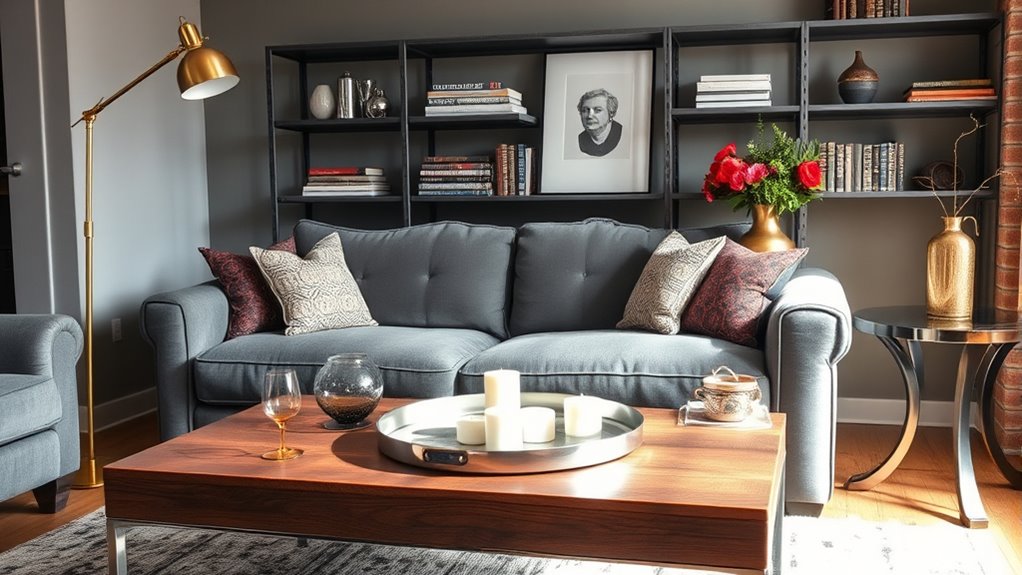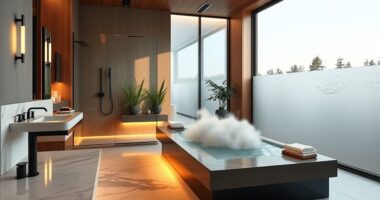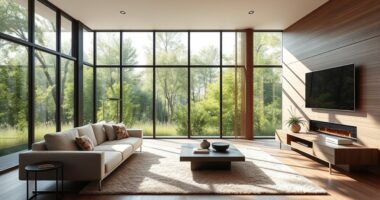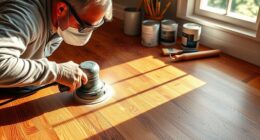Mixing metals in home design can create a striking, modern aesthetic. Start by choosing 2-3 metal types, establishing one as your dominant metal, which should appear in at least two locations. Use the 60-30-10 rule to maintain balance and avoid conflicting finishes. Pair warm and cool metals thoughtfully, enhancing spaces with complementary contrasts. Keep scales and finishes distinct for clarity in design. There's so much more to explore about crafting the perfect mixed-metal look!
Key Takeaways
- Choose 2-3 metal types to create a cohesive look, ensuring a dominant metal covers 60% of the elements in the design.
- Apply the 60-30-10 rule for metal distribution: 60% dominant, 30% secondary, and 10% accent metals for balanced aesthetics.
- Pair contrasting metals thoughtfully, such as warm brass with cool nickel, while maintaining distance to allow each to shine.
- Ensure consistency in finishes, particularly for plumbing fixtures, to unify the overall design and avoid visual clutter.
- Create mood boards to visualize metal combinations, balancing personal style with desired ambiance for effective design planning.
Understanding the Basics of Metal Mixing
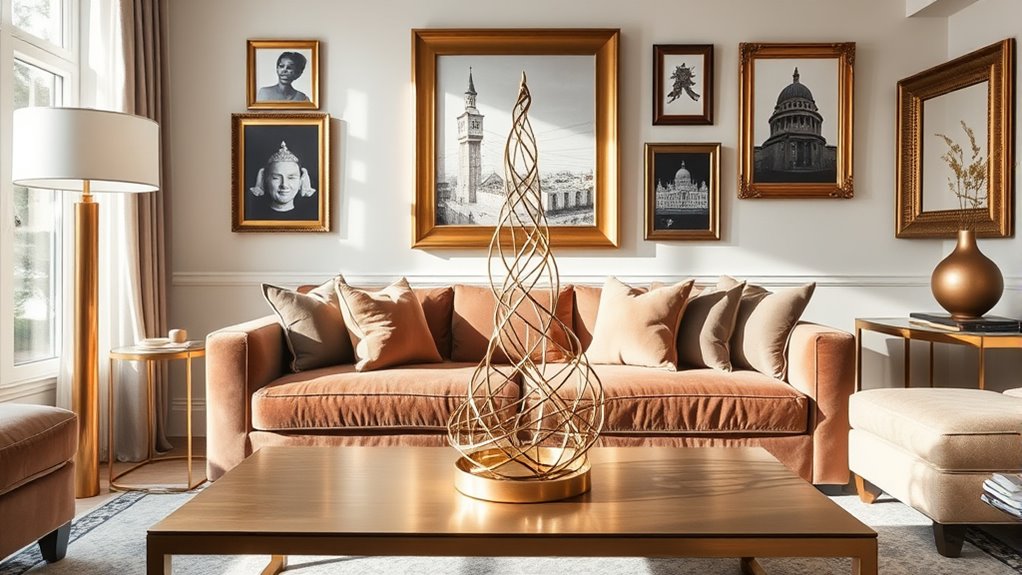
When mixing metals in home design, it's important to strike the right balance. Start by limiting your selection to 2-3 metal types to create a cohesive look.
Using a dominant metal sets the tone for your space, while the others can act as accents. A mixed metal look thrives on variety in metal finishes, so consider pairing polished brass with matte bronze for added depth.
A dominant metal establishes the atmosphere, while accents in varied finishes, like polished brass and matte bronze, enhance depth.
Warm metals naturally complement each other, while cool metals like stainless steel can create striking contrasts. Remember the 60-30-10 rule to distribute metals effectively, ensuring one remains dominant.
Consistency in plumbing fixtures helps unify the design, allowing other areas to showcase a curated blend of finishes that adds character to your home.
Identifying Your Dominant Metal
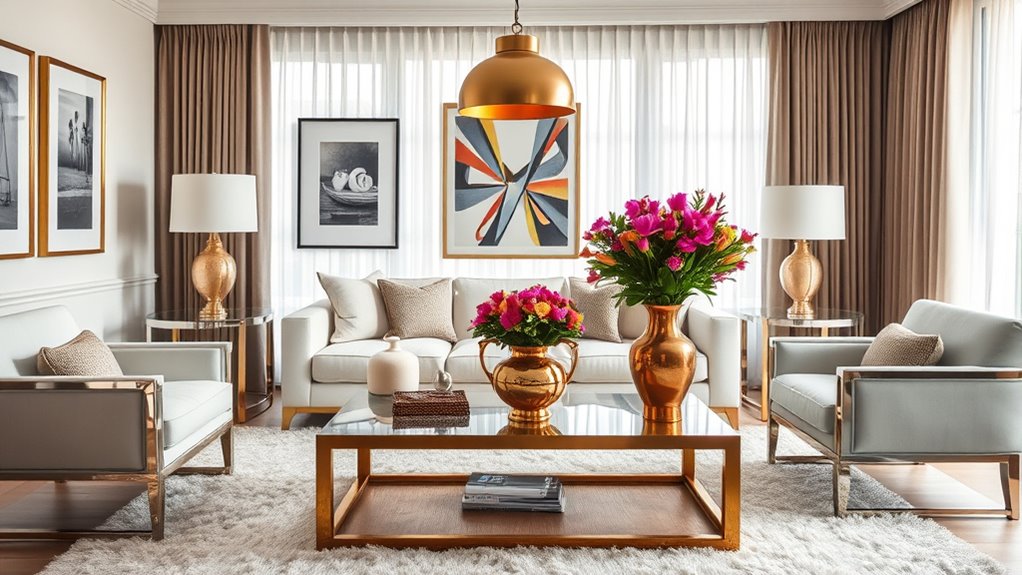
Selecting your dominant metal is a key step in shaping the overall design of your space. This metal will establish the tone and guide your metal mixing. Aim to follow the 60-30-10 rule: your dominant metal should represent about 60% of the metal elements for visual balance. Consistently use it across fixtures—like cabinet handles and plumbing—to create a cohesive look.
| Metal Type | Best Use |
|---|---|
| Brass | Formal spaces |
| Polished Nickel | Modern areas |
| Matte Black | Casual settings |
Consider the undertones as well; warm metals harmonize, while cool metals do the same. With careful selection, your dominant metal will enhance your design. Incorporating natural elements into your decor can further promote a serene atmosphere.
Exploring Complementary Contrasts
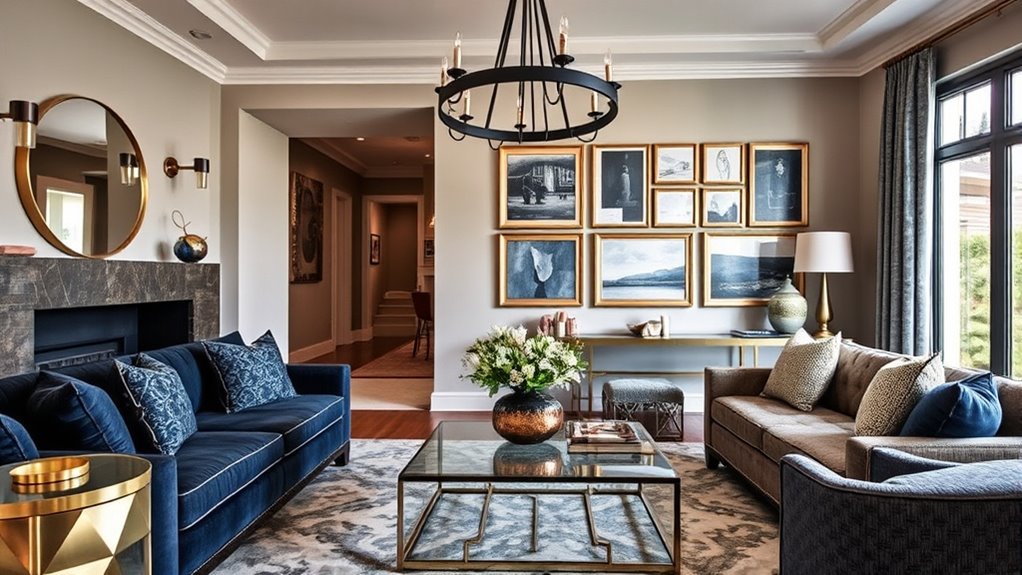
With your dominant metal established, it's time to explore how complementary contrasts can elevate your design. Mixing metals like warm brass finishes with cool polished nickel creates a striking balance, adding depth to your space.
Establish your dominant metal and mix contrasting finishes for a striking balance that elevates your space.
You can also incorporate contrasting finishes, such as matte black with shiny brass, to achieve a dramatic effect that enhances your overall aesthetic.
Remember the 60-30-10 decorating rule; this guarantees your dominant metal shines while others provide support and contrast. Place each metal in at least two locations throughout the room to maintain a cohesive look.
Avoid similar finishes like satin and polished brass to prevent visual confusion, ensuring your mixed metals remain distinct and beautifully curated.
The Role of Undertones in Metal Selection
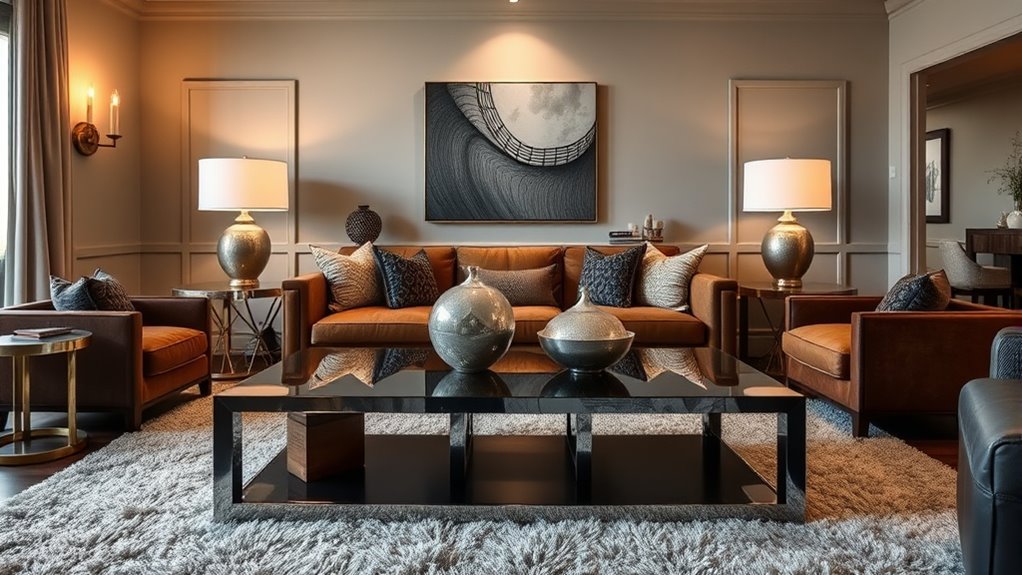
Understanding metal undertones is essential for creating a cohesive design in your home. By recognizing how metals throughout your space interact, you can achieve design harmony. Warm undertones, like those found in brass and bronze, can create inviting atmospheres, while cool metals such as polished nickel provide a revitalizing contrast.
| Metal Type | Undertone | Ideal Pairing |
|---|---|---|
| Brass | Warm | Polished Nickel |
| Bronze | Warm | Stainless Steel |
| Copper | Similar to Brass | Avoid pairing |
| Gold | Warm | Silver |
Mixing contrasting metals enhances visual interest, but remember: similar tones can clash. Choose wisely for a balanced look!
Creating a Cohesive Aesthetic
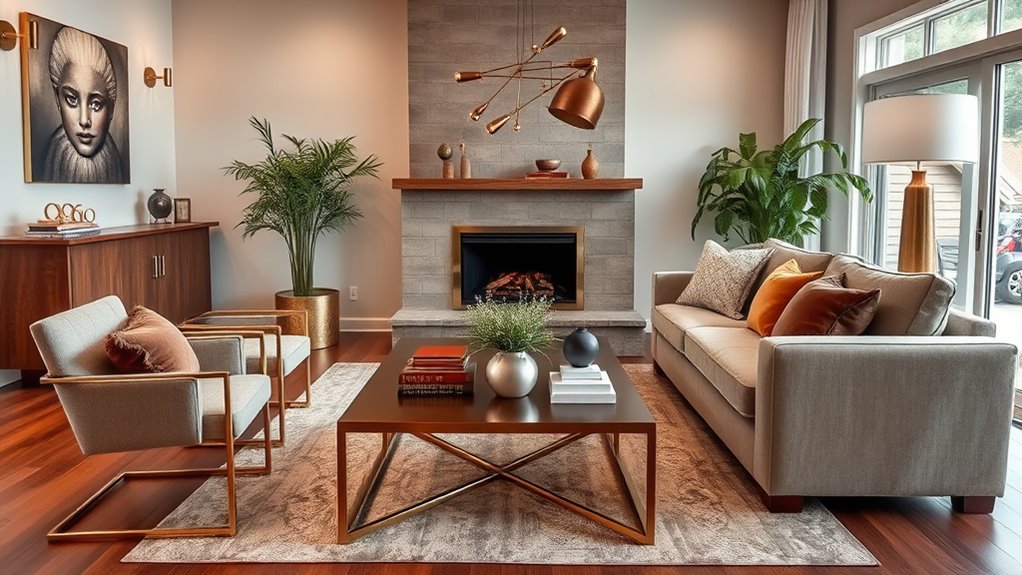
To create a cohesive aesthetic with mixed metals, start by intentionally pairing one dominant metal with one or two contrasting options.
Balance is key, so aim for a 70/30 distribution to maintain consistency throughout your space.
Remember to keep metals at a comfortable distance, allowing each to shine without competing for attention.
Intentional Metal Pairings
Creating a cohesive aesthetic in your home design starts with intentional metal pairings that balance both style and function. Choose one dominant metal to guide your design, then pair it with one or two contrasting metals for visual interest. Here are some effective pairings to contemplate:
| Dominant Metal | Contrasting Metals |
|---|---|
| Polished Nickel | Matte Black, Aged Bronze |
| Brass | Aged Bronze, Polished Nickel |
| Copper | Blackened Steel, Silver |
| Oil-Rubbed Bronze | Satin Nickel, Chrome |
| Matte Black | Brass, Polished Nickel |
Aim to distribute metals throughout your space—each type should appear in at least two locations. Following the 70/30 rule helps achieve visual balance, ensuring your dominant metal reigns supreme.
Balance and Consistency
Achieving balance and consistency in your home design can transform a space from chaotic to cohesive, especially when mixing metals.
Start by selecting a dominant metal to guide your design, then apply the 60-30-10 rule for an even distribution of finishes.
Here are some tips to take into account:
- Limit the number of metal types to 2-3 per room.
- Verify each metal appears in at least two places for a curated look.
- Maintain distance between mixed metals to enhance appreciation.
- Choose fixtures with consistent metal to unify the design.
Limitations on Metal Variety
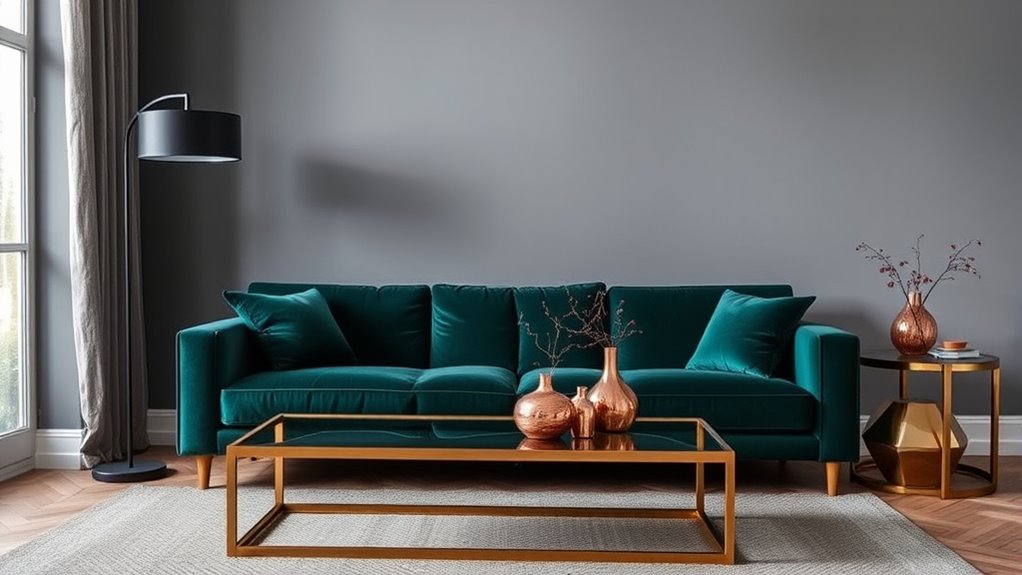
While mixing metals can add depth and interest to your home design, overdoing it can lead to a chaotic look. To achieve a cohesive look, limit your metal variety to 2-3 types. In small rooms, stick to one or two metals, while larger spaces can embrace two to three for visual balance. Establish a dominant metal to guide your design, allowing other metals to complement it without overwhelming.
Here's a table to help you visualize metal distribution:
| Metal Type | Usage Example |
|---|---|
| Dominant | Light fixtures |
| Secondary | Cabinet handles |
| Accent | Decorative items |
| Minimal | Small accessories |
| None | Avoid excess metals |
Balancing Warm and Cool Metals
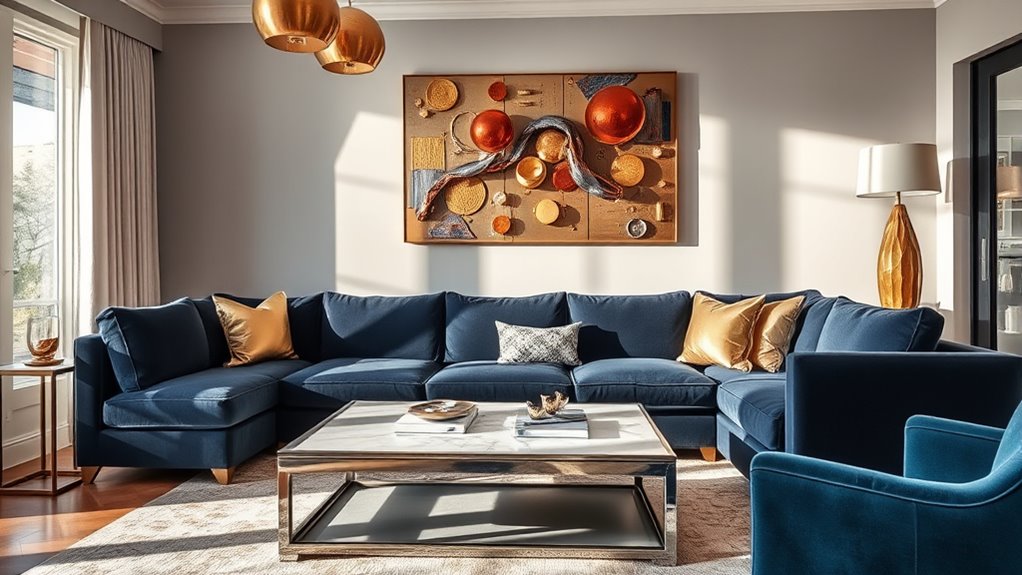
Once you've established a limited variety of metals in your design, consider how warm and cool metals can work together to enhance your space.
Combining warm metals like brass and bronze with cool metals such as polished nickel and chrome creates a balanced aesthetic. This intentional contrast adds depth and sophistication, ensuring no single metal dominates your decor.
Combining warm metals like brass and bronze with cool metals like polished nickel creates a sophisticated, balanced aesthetic in your decor.
To effectively balance warm and cool metals, think about:
- Using warm metals for cozy areas, like bathrooms
- Incorporating cool metals in modern spaces, like kitchens
- Adding a second warm metal, like bronze, to complement brass
- Strategically distributing metals throughout the room for a curated look
This approach not only enhances your design but also guides the overall mood, much like creating an interior design mood board that reflects your desired atmosphere.
Practical Tips for Mixing Metals
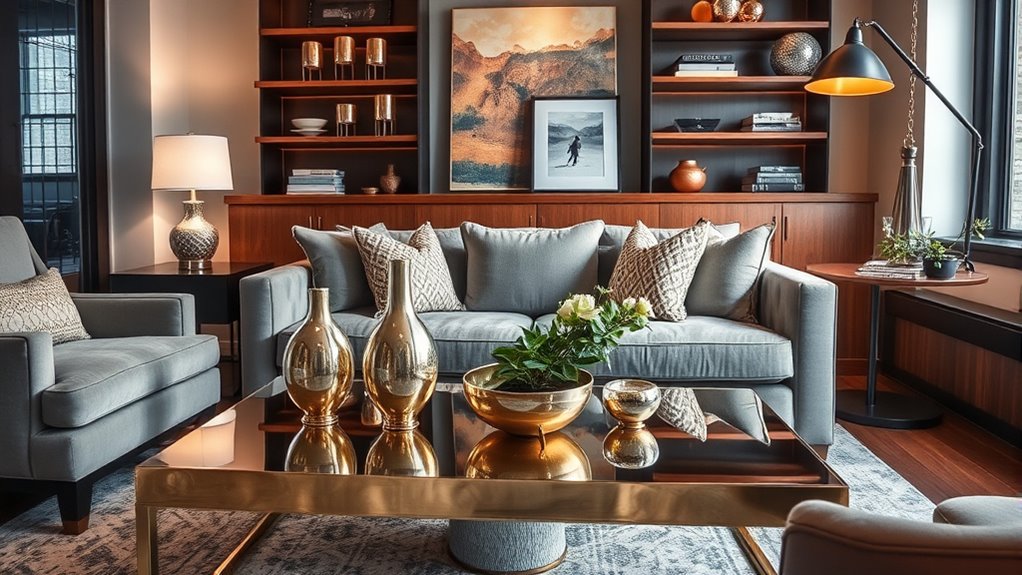
When mixing metals in your home, start by selecting complementary finishes that enhance each other.
Keep balance in mind by distributing metallic elements thoughtfully across your spaces.
Finally, don't shy away from showcasing your personal style; it's all about what makes you feel at home.
Select Complementary Metal Finishes
To create a visually striking space, you need to select complementary metal finishes that intentionally contrast yet harmonize with one another.
When mixing metals, pair satin nickel with polished brass for an appealing look. Incorporate both warm-toned metals, like brass or bronze, and cool-toned finishes, like polished nickel, to achieve balance.
Here are some practical tips:
- Limit your choices to 2-3 metal types.
- Verify each metal appears in at least two places for cohesion.
- Use the 60-30-10 rule to guide your distribution.
- Be mindful of undertones to maintain harmony, especially when mixing brass and polished metals.
Balance Proportions Across Spaces
Achieving balance in your space while mixing metals involves careful consideration of proportions.
To create a harmonious look, stick to the 70/30 rule: use one dominant metal for 70% of the design and incorporate contrasting finishes for the remaining 30%.
Limit yourself to 2-3 types of metals to keep your aesthetic cohesive and avoid overwhelming the space.
Be mindful of proximity; placing metals with subtle differences too close can confuse the eye.
To enhance unity, guarantee each metal type appears in at least two locations throughout the area.
In smaller rooms, opt for just one or two metals to maintain clarity and prevent a cluttered appearance.
Balancing proportions is key to successful metal mixing.
Embrace Personal Style Choices
Embracing your personal style is essential when mixing metals in home design, as it creates a space that truly reflects who you are.
Start by selecting metals that resonate with your personal preferences, leading to a cohesive design. Consider these practical tips:
- Choose a dominant metal to shine in your space.
- Combine finishes from the same metal family for unity.
- Use mood boards to visualize your ideas and guarantee alignment with partners' preferences.
- Apply the 70/30 rule for balance, letting your dominant metal lead while adding secondary metals for contrast.
Don't shy away from creating a curated look; intentionally mixing metals can showcase your unique aesthetic and tell a compelling story through your home decor.
Common Mistakes to Avoid

While mixing metals can add depth and character to your home design, there are common mistakes you'll want to avoid to maintain a cohesive look.
First, limit your mix of metals to two or three types; using too many can create a cluttered appearance.
Next, watch out for finishes that clash, like satin brass versus polished brass, as this can lead to visual dissonance.
Consistency is key, especially with plumbing fixtures—ensure they share the same finish for a harmonious look.
Overcrowding the space with competing metals can overwhelm the design, so embrace negative space.
Finally, don't ignore the 70/30 rule; letting one metal dominate can disrupt the intended balance and harmony in your design.
Personal Style and Metal Choices
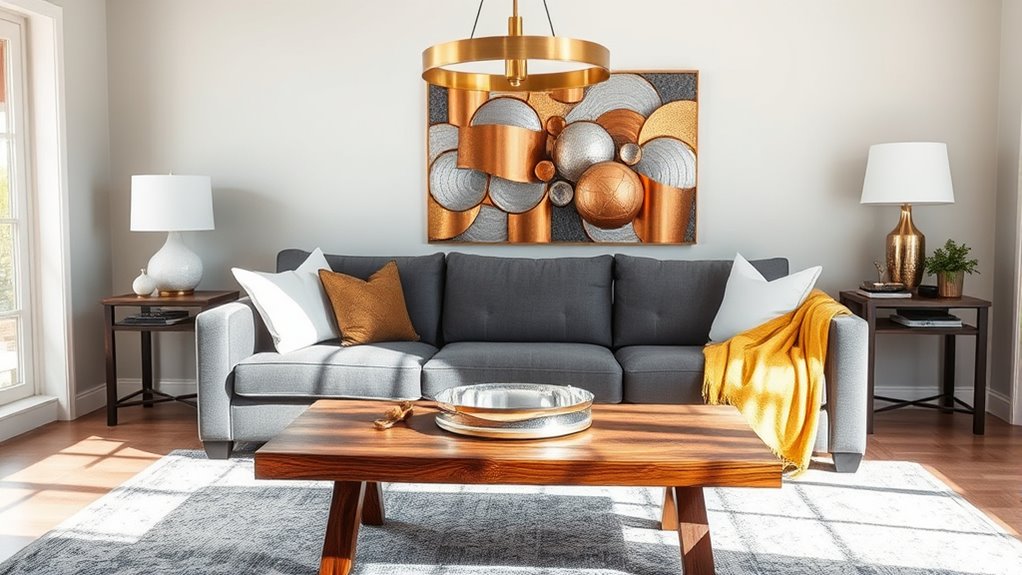
Your personal style is key to choosing the right metals for your home, as it reflects your unique taste.
Balancing your preferences with those of your partner can lead to creative combinations that enhance your space.
Defining Your Aesthetic
Defining your aesthetic starts with understanding personal style and how it influences metal choices in home design. Your unique preferences shape the atmosphere you want to create.
Consider warm metals like brass and bronze for a cozy feel, or pair them with cooler metals such as polished nickel for balance. Think about how metal combinations reflect the desired ambiance of each space.
Here are some tips to guide you:
- Identify your favorite metal tones.
- Reflect on the room's purpose and mood.
- Create mood boards to visualize combinations.
- Make certain metals harmonize without clashing.
- Understanding personal influences can further refine your choices and enhance your overall design vision.
Balancing Personal Preferences
Balancing personal preferences in metal choices is vital for creating a harmonious home design. Your personal style greatly influences how mixed metals can shape the overall aesthetic of your space.
To achieve balance, think about how the warmth of brass and gold pairs with cooler tones like polished nickel or chrome. Using mood boards can help you visualize different finishes and guarantee your style aligns with your design goals.
If you're collaborating with a partner, it's important to communicate openly about your preferences to find common ground. Mixing metals effectively requires understanding how these different finishes interact, allowing you to curate a look that feels uniquely yours while remaining cohesive in your home.
Exploring Metal Combinations
While exploring metal combinations, it's essential to reflect on how your personal style influences the overall aesthetic of your home. Mixing metals allows you to express your individuality, so consider how different metals can create various atmospheres.
For instance, a brass light fixture paired with polished nickel can add warmth and sophistication, while matte black with brass enhances a contemporary vibe.
To create a balanced look, think about these key points:
- Dominant metal guiding the design
- Use of two to three metals for harmony
- Mixing finishes for visual depth
- Align combinations with your intended style
Frequently Asked Questions
Is It OK to Mix Metals in Interior Design?
Absolutely, it's okay to mix metals in interior design!
You'll find that combining different finishes adds depth and visual interest to your space. Just keep it to two or three types of metal for a cohesive look.
Make sure each metal appears in at least two places to create harmony. Remember to choose a dominant metal and balance it with the others, ensuring they complement rather than clash.
Enjoy the creative process!
Can You Mix Metals in a Kitchen Design?
They say variety is the spice of life, and you can definitely mix metals in your kitchen design.
Combining metals like brass and stainless steel creates visual interest and depth. Just remember to keep it balanced—limit yourself to two or three different metals to avoid clutter.
Use the 70/30 rule, letting one metal dominate while the others complement, ensuring your kitchen feels cohesive and thoughtfully designed.
You'll love the results!
How to Use Metal in Interior Design?
When you're using metal in interior design, start by choosing a dominant metal to anchor your space.
Think about the different tones—warm metals like brass or cool ones like chrome. Incorporate your chosen metal in various elements, such as light fixtures, furniture, or accessories, to create harmony.
Keep it simple by limiting yourself to two or three types to avoid clutter. Balance is key, so mix intentionally for a cohesive look you'll love.
Are Mixed Metals Still in Style?
Yes, mixed metals are still in style!
You'll find that combining warm and cool metals adds depth and character to your space. Limiting your mix to two or three types helps maintain a cohesive look, especially in smaller areas.
Modern trends favor bold contrasts, and using metals like matte black alongside polished nickel can create striking aesthetics.
Embrace this trend to showcase your personal style and keep your home feeling fresh and contemporary.
Conclusion
So, you've mastered the art of mixing metals in your home design, right? Who knew it could be so easy to create a stunning look by pairing gold with silver, or brass with chrome? It's almost like you're a trained designer now! Just remember, even the pros sometimes mix it up a little too much. But hey, as long as you love it, that's what really matters—after all, there's no such thing as too much shine!
